Posts Tagged: caneberry
Announcing the 2017 UCCE Annual Caneberry Meeting
Announcing the 2017 Annual Caneberry meeting.
Meeting will be held at the UC Cooperative Extension office at 1430 Freedom Blvd (Suite E) in Watsonville on February 14. Solid material from start to finish - following a brief regulatory update, we'll talk about spotted wing drosophila, have a look at options to methyl bromide fumigation thanks to our colleague Inga Zasada from Oregon and then explore the issue of fruit deformity in blackberry with UCCE's own Shimat Joseph and Mark Gaskell.
Agenda below.
Hot breakfast to be served before the meeting. See you there!
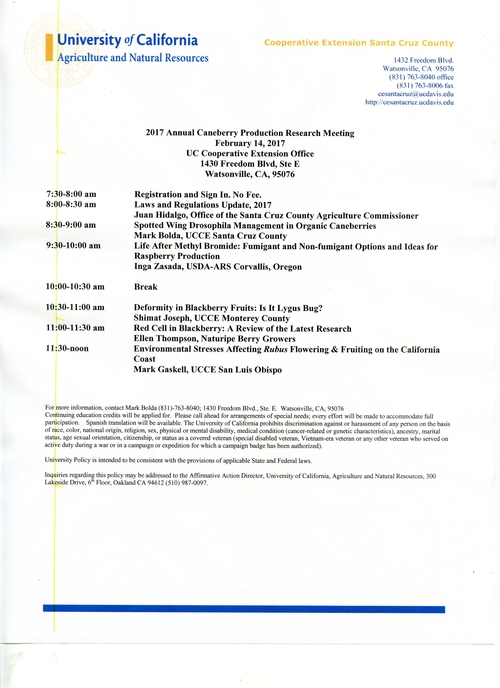
Caneberry Meeting252
Thinking Deeply about Magnesium
Magnesium (Mg) has several purposes in the plant, one of the main ones being the central position in the ring of the chlorophyll molecule. Thus, it is very important for plant photosynthesis. The other roles magnesium has in plants are parts in respiration and energy metabolism. Magnesium is considered a secondary plant nutrient, because it is needed in fairly large amounts by plants.
Magnesium moves with the water to the roots of the plant as the cation Mg2+, meaning the plant does not actively take it up and making root surface size and area an important factor in accumulation. Therefore, Mg2+ deficiency can occur when root growth is comprised or the soil is too dry. Interpreting soil analyses for magnesium content is not easy, because it is usually not the total amount that determines whether a deficiency can occur, but the relative proportion of Mg to calcium and potassium in the soil. Furthermore, high levels of magnesium can cause deficiencies of these other nutrients as well.
When interpreting soil analyses, bear in mind that “exchangeable Mg2+” and “saturated paste analysis Mg2+” are not measuring the same thing. Only a percentage of exchangeable Mg2+ is available to the plant at any given time, the rest being bound to soil particles, colloids and organic matter. The saturated paste analysis better represents what the plant root would encounter at the time of sampling, but this number will vary with the amount of rain or irrigation at that time.
A rule of thumb would be that saturated paste soil test values for Mg2+ above 0.5 meq/l represent sufficient amounts. Pajaro and Salinas Valley soils tend to be well above this threshold and thumbing through my numerous soil analyses taken from these areas from the past few years, I'm not finding a single one underneath it.
Being as they are fundamentally chemistry labs, many soil analysis reports will be expressed in other units. Some labs report soil magnesium as ppm exchangeable Mg, for example “82 ppm”. For magnesium, meq/100 g x 120 = ppm. Therefore, 82 ppm Mg is the same as 0.7 meq. Luckily, most labs also provide some sort of graph that shows where the nutrient lands on the sufficiency index. Most soils are not considered deficient unless exchangeable Mg is less than 25 – 50 ppm.
Magnesium comes from rock and clay particles as they weather over time. The needs of strawberries and caneberries are around 40 -100 lb of Mg2+ per acre per season, meaning that soil analysis prints above several hundred pounds or even in the thousands in the top six inches indicate sufficiency (Mg ppm x 2 = lbs/top 6” of soil). Again, since this is measured as exchangeable magnesium, not all of it is available at any given time.
A low soil pH under 5.4 can be restrictive for plant magnesium availability, and to a lesser extent (because there is so much magnesium already around) other cations such as potassium and calcium can also contribute to deficiency. For example, plant deficiencies of magnesium can occur in soils where the calcium to magnesium ratio (Ca/Mg ratio) exceeds 7 on a meq basis. High levels of exchangeable potassium can also interfere with magnesium uptake. Conversely, the opposite is true. For example, in soils derived from serpentine rocks exchangeable magnesium can exceed calcium. This can cause some interesting plant growth characteristics in other crops, such as yellow shoulder in tomatoes where these are grown on high magnesium soils common to the west side of the San Joaquin Valley.
Looking at the revision of plant nutrient levels produced by Tim Hartz et al in 2012, sufficiency levels of Mg in strawberry leaf tissue are 0.33 – 0.45 % prior to the onset of fruiting and then at 0.2 to 0.4 % during the harvest season. In caneberries, according the Dr. Bernadine Strik at OSU, the optimum range is just a bit higher, with recommended values being 0.3 to 0.6 % during fruiting.
http://www.oregon-strawberries.org/attachments/2013-May_Nutrient_Management_Berry_Crops_OSU.pdf
Really a take home conclusion here is that most, if not all, of our Pajaro and Salinas Valley soils are well supplied with magnesium, and any deficiencies, should they arise, are stemming from physiological problems of the plant or chemical properties of the soil.
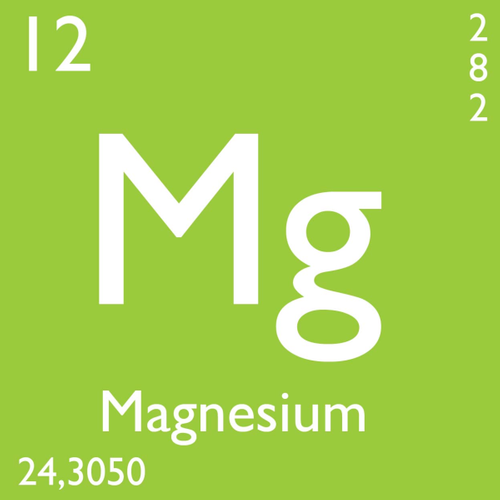
What is the role of the element magnesium in berry culture?
Annual Central Coast Caneberry Meeting Announcement
If you at all have any production relationship to caneberries, you should not miss this caneberry meeting. My colleague Mark Gaskell has brought in caneberry experts from around the country to put together probably the best caneberry meeting we have ever had!
Meeting will take place February 3 at the Veteran's Memorial Building on 780 Bello Street in Pismo Beach, California. Sign in starts at 8 am, meeting starts at 815 am.
Agenda posted below.
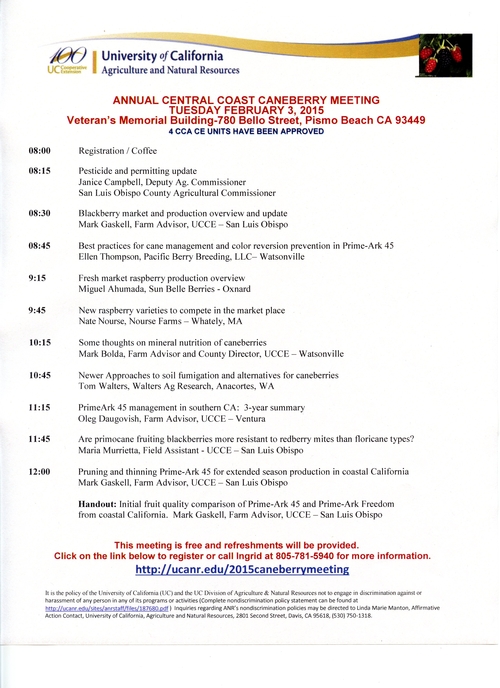
Annual Caneberry Meeting February 3, 2015
Data Driven Decision Making: Finding Success in Plant Diagnostics and Stock Speculation
Stock speculation and plant diagnostics are surprisingly similar in the process and attitudes necessary for successful outcomes. In both endeavors, one must address an issue by gathering data about it, assess it correctly and make a decision in a timely matter.
The beauty of the stock market, and the lesson it provides those of us working in other areas of data driven decision making, is how swiftly information that really matters is integrated into the prices of shares. The successful stock operator needs to be constantly mindful of the data capable of influencing the present and future prices of the shares he or she is considering purchasing or selling. Not everything crossing the ticker tape or news crawl on the bottom of the screen is of equal value. Market commentary of the popular punditry and prognosticators is near useless (and potentially dangerous) in making decisions, while unexpected electoral outcomes and even small changes in national bank policy of large economies will have significant effects on markets. The key point is that information of real value is almost instantly reflected in the price of shares, putting the ability to identify the facts and make sound decisions on them quickly at a real premium and quite often will result in profitable speculation.
In the same vein, the effective plant diagnostician should ignore guesses and empty theories all the while taking into full consideration all the possible information about a problem available at that time. Experience tells us that in berries, it is valuable to pay attention to the duration of transplant cold conditioning, planting date, source nursery, type of fumigation or preplant treatment, plant tissue mineral concentrations, soil physical and chemical composition, plant establishment practices, former and current presence/absence of major pests, irrigation practices and fertilizer management.
While in plant diagnostics the practitioner is spared the split second requirement to make a decision as on the stock market, there is still a premium on making sound decisions and acting on them in a timely manner. The effects of unaddressed maladies are incorporated into current and future plant performance rapidly, and so the time to address a problem is nevertheless very soon after the complaint is noticed or received.
In the assessment of the data in reference to making a decision, one of the biggest mistakes a stock speculator and plant diagnostician can make is to create narratives, in other words stories, to explain what is occurring. Narratives have been a wonderful mechanism for humans to understand and survive in a constantly changing and bewildering world, but they can also lead to the creation of dangerous and misleading fictions, which elevate some information over other data vital to a true picture of what is really happening.
Take for example the rush to buy gold on the part of many investors over the past few years. Historic levels of Federal Reserve monetary activity through the release of billions and billions of dollars into circulation concurrent with significant government intervention in the economy compelled some investors to create a narrative of impending hyperinflation, and had them seeking refuge in the supposed store of eternal value in gold. This narrative of roaring inflation in the near future blinded many to the fact that through this entire time, the prices of Treasury bonds, which are a measure of the market's faith in the US government along with being extremely sensitive to and wary of inflation, were hitting all time highs in price arising from unprecedented demand. This cherry picking of facts and the creation of a story by some market participants resulted in a pretty decent bubble in gold for several years but now whose fiction has been cruelly exposed by the sharp drop in gold prices over the past two months (Figure 1 below).
Similarly, approaching a berry field and creating a narrative by focusing on and elevating one factor and ignoring the many other possibilities can result in a mistaken or incomplete diagnosis. Just because you find a pest or identify one problem doesn't necessarily mean that's all of it.
Take for example the issue of yellow leaves in strawberries (Figure 2 below) and caneberries. It has been a habit to simply refer yellowed leaves to some nutritional deficiency such as nitrogen, iron or zinc. A simple check in the literature or the web shows that indeed leaves can become yellow when one of these vital minerals is lacking, but which one? Furthermore, let me assure you as a person who makes a lot of diagnostic field visits that there are many, many causes of yellowing of strawberry and caneberry leaves! Each case really needs to be fully investigated on its own merits, lest the cure applied is not the right one, allowing valuable time to slip by and the plant declines further in yield potential or ends up wilting and dying. Much as the narrative-creating gold bugs in the above example lost vast sums of money in the recent sell off, growers acting on the narrative that iron is the cause of a given case of yellowed leaves because that's the way it looks in the book and then going on to ignore all of the other things in that field are going to get hit with a big loss if it turns out to be something else.
I would like to close this article with a note about proper attitude. As human as it is to err, it is even more human to not want to admit to making mistakes. Both plant diagnosticians and stock speculators must be able to neutrally approach their craft, because stubbornness and an inability to admit being wrong means you have mentally blocked out the possibility of making any decision other than the one to which you have attached yourself. It's very hard for many of us to fess up to a mistake because it's embarrassing or we are emotionally attached to our theory or whatever, but the net result of this inability to make the necessary change in attitude to agree with what is truly happening will be a failure to achieve the right solution to the real problem.
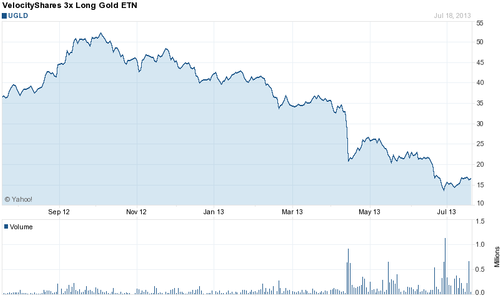
Figure 1: Dude, what happened to my gold fund?
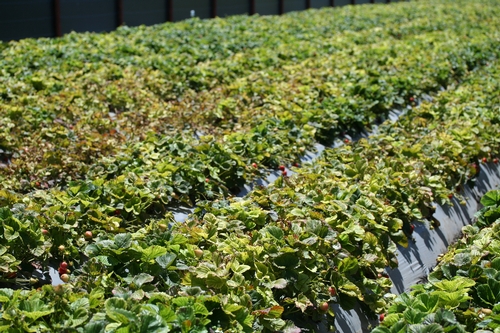
Figure 2: Are these plants really short of iron?
Caneberry Meeting Planned for January 11, 2013
There is a caneberry meeting sponsored by UC Cooperative Extension planned for January 11 of the new year. Featured will be talks about cost and returns of growing primocane raspberries under tunnels by UCCE Farm Management Advisor Laura Tourte, general talks on yield enhancement work and pest management by yours truly, further insight on spotted wing drosophila by UC Davis' Kelly Hamby, irrigation managment by UCCE water guru Michael Cahn, primocane blackberry management by UCCE Farm Advisor Mark Gaskell, and a regulatory update courtesy of the Santa Cruz Agricultural Commissioner's office.
Agenda is posted at:
http://cesantacruz.ucanr.edu/files/158012.pdf
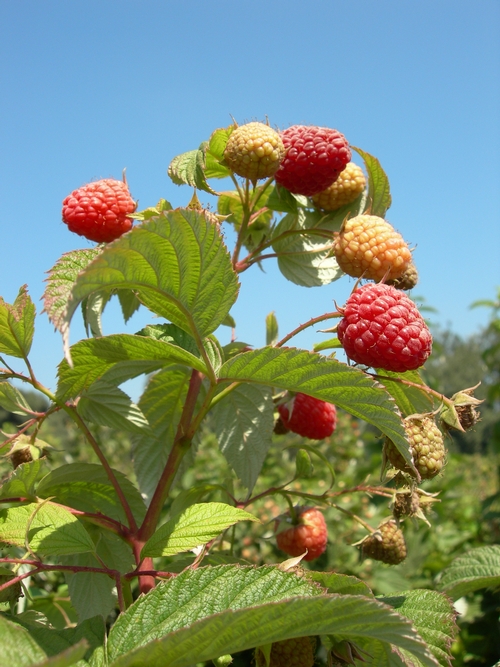
This year's Annual Caneberry Meeting will be held January 11 at the UCCE office in Watsonville.

